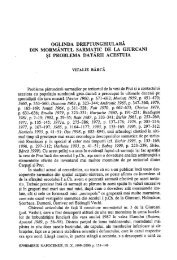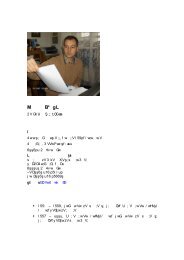EPHEMERIS NAPOCENSIS - Institutul de Arheologie şi Istoria Artei
EPHEMERIS NAPOCENSIS - Institutul de Arheologie şi Istoria Artei
EPHEMERIS NAPOCENSIS - Institutul de Arheologie şi Istoria Artei
You also want an ePaper? Increase the reach of your titles
YUMPU automatically turns print PDFs into web optimized ePapers that Google loves.
“Spa” Vignettes in Tabula Peutingeriana. Travelling Ad Aquas<br />
6. Concluding remarks. The thermal settlements and the road system<br />
Germisara, Ad Aquas and Ad Mediam represent three important Roman thermal settlements<br />
from Dacia. It is obvious, from what I presented above, that all three were intensively<br />
visited. These points of attractions offered for the inhabitants the opportunity, the chance for<br />
healing, but they also were perceived as touristic settlements. These ‘resorts’ offered what the<br />
Romans borrowed from Greeks: the concept of leisure as a state of mind. They all were connected<br />
to the road infrastructure of roads. Germisara was positioned 7 kilometers north of the main<br />
roads of Dacia and connected with another road, well preserved even nowadays. Ad Mediam<br />
was positioned 5 kilometers east of the road which connected Dierna (today Orşova, Mehedinţi<br />
County). The toponym itself indicates a settlement positioned close to the middle part of this<br />
road. Ad Aquas (Călan, Hunedoara County) was located along the main road of Roman Dacia,<br />
which connected the Danube line with the northern parts of Dacia, via Le<strong>de</strong>rata – Tibiscum<br />
– Ulpia Traiana Sarmizegetusa – Apulum – Potaissa – Napoca – Porolissum. This road was the<br />
‘highway’ of Roman Dacia. It was built during the two military camapaigns of Trajan in Dacia<br />
and finished immediately after the conquest. A Roman milestone discovered at Aiton (between<br />
Potaissa – today Turda, Cluj County, and Napoca, today Cluj-Napoca, Cluj County) dated in<br />
108 AD, during Trajan, <strong>de</strong>monstrates that the Romans succee<strong>de</strong>d to built this road up to the<br />
northern parts of the province.<br />
Using the infrastructure, and all the facilities created, including a rapid colonization<br />
of the new province (Eutropius, Breviarum ab urbe condita, 8, 6: Traianus victa Dacia ex toto<br />
urbe Romano infinitas copias hominum transtulerat ad agros et urbes colendas), people of all social<br />
statuses (soldiers, functionaries of the states) started to travel, to communicate, to benefit of all<br />
the advantages of the new province. The society of Roman Dacia (as well as of the whole Roman<br />
Empire) became very dynamic. These three thermal settlements were very attractive, as the<br />
archaeological finds and inscriptions inform us. Communication, as an essential element for any<br />
civilization, was done ‘physically’ by infrastructure, which provi<strong>de</strong>d opportunities for goods and<br />
people to travel and organize a territory. Communication also meant the possibility for people<br />
to travel, to interact, to exchange information.<br />
My examples, together with others already known from other provinces, are strong<br />
evi<strong>de</strong>nces to contradict with solid arguments the old concepts spread in the historiography,<br />
according to which the Roman Empire was a space of static communities. On the contrary, we<br />
discover, step by step, the huge resources of the Roman Empire and how people interacted with<br />
themselves and with the landscape.<br />
ABBREVIATIONS AND BIBLIOGRAPHY<br />
IDR<br />
Inscriptiones Daciae Romanae (București)<br />
ALBU 2005<br />
E. ALBU, Imperial Geography and the Medieval Peutinger Map. Imago Mundi 57, 2005,<br />
136–148.<br />
ALBU 2008<br />
E. ALBU, Rethinking the Peutinger Map. In: R. J. A. Talbert/R. W. Unger (Eds.), Cartography<br />
in Antiquity and Middle Ages: Fresh Perspectives, New Methods (Lei<strong>de</strong>n 2008), 111–119.<br />
BLACKMAN/TREVOR 2001<br />
D. R. BLACKMAN/A. H. TREVOR, Frontinus’ Legacy: Essays on Frontinus’ <strong>de</strong> aquis urbis<br />
Romae (Michigan 2001).<br />
219















